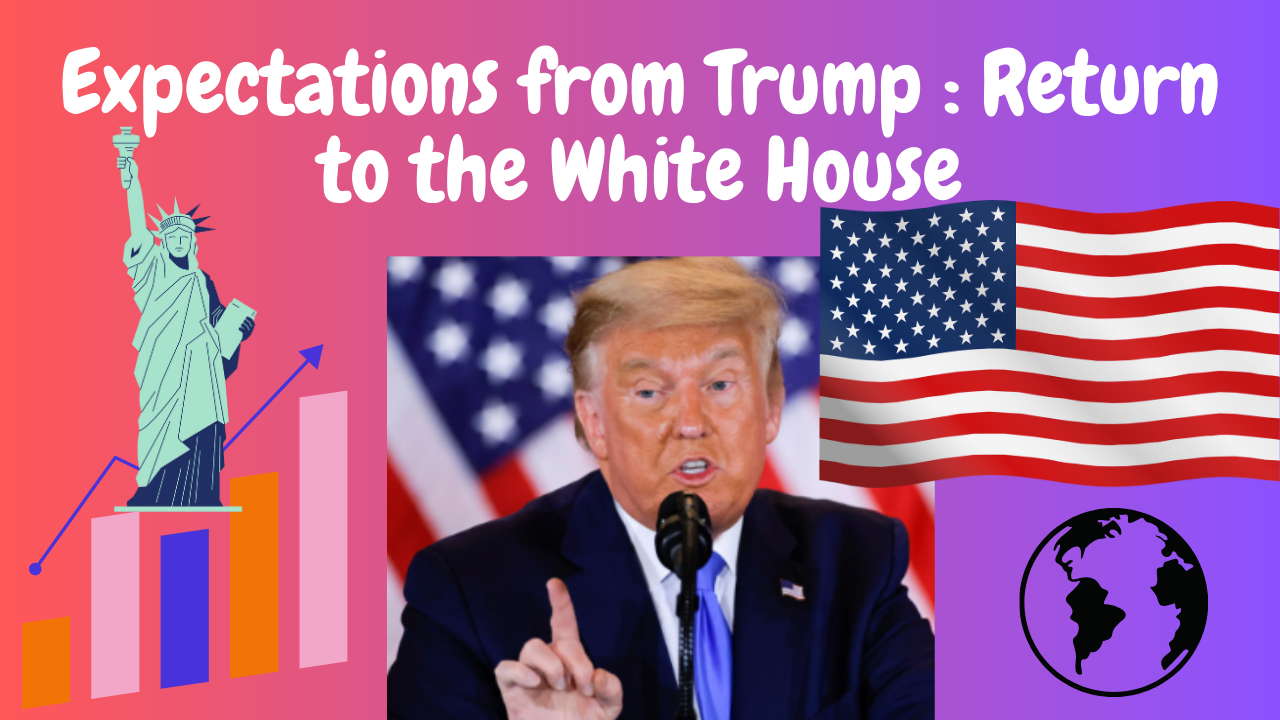With Donald Trump’s return to the White House, the geopolitical landscape faces a new era of potential shifts in diplomacy, economic policies, and alliances. Trump’s presidency is known for its emphasis on “America First,” and his second term promises to bring new dynamics to the global stage. Below, we explore some key areas where changes might occur and what the world’s expectations from Trump in terms of geopolitics.
1. Revised U.S.-China Relations (Expectations from Trump)
A hallmark of Trump’s foreign policy has been a strong stance on China, particularly on trade, technology, and military issues. Trump may likely intensify measures against China, including tariffs, sanctions on Chinese companies, and restrictions on technology transfers. This approach could escalate the tech rivalry between the U.S. and China, impacting global supply chains and increasing the drive for “de-risking” or decoupling.
The South China Sea and Taiwan are likely to remain flashpoints. With potential U.S. support for Taiwan, China’s military response could increase in intensity, risking regional instability. Countries within the Asia-Pacific region may be compelled to choose sides in this escalating rivalry, further polarizing global alliances.
2. Strained Relations with NATO and European Allies
Trump has been a vocal critic of NATO, questioning the U.S. commitment to its allies and pushing for increased defense contributions from European countries. While he may not withdraw from NATO entirely, his approach could lead to a less stable transatlantic alliance. This could force European allies to re-evaluate their security strategies, perhaps moving towards greater self-reliance.
Additionally, Europe may diverge from the U.S. on other global issues, such as climate policy, where Trump’s stance has typically differed from Europe’s. This divergence could create fractures in U.S.-Europe cooperation on global issues like energy policies and digital regulation.
3. Middle East Dynamics and U.S.-Iran Relations (Expectations from Trump)
Trump’s previous term included the withdrawal from the Iran Nuclear Deal (JCPOA) and the imposition of “maximum pressure” sanctions on Iran. His return might revive this strategy, leading to heightened tensions and potentially impacting the stability of the Middle East. This could influence Iran’s regional power dynamics and create closer ties between Iran and other U.S. rivals, such as Russia and China.
The Abraham Accords, which normalized relations between Israel and several Arab nations, could expand under Trump’s leadership. Trump may push for further diplomatic breakthroughs, possibly including Saudi Arabia. However, this realignment could further isolate Iran, raising the risk of conflict in the region.
4. Reassessment of U.S.-Russia Relations (Expectations from Trump)
During his first term, Trump faced criticism for his approach to Russia, often seen as more lenient than previous administrations. His second term might bring more complex dynamics to U.S.-Russia relations. The ongoing conflict in Ukraine will be a significant factor, with the possibility that Trump may push for a peace settlement, potentially through negotiations favorable to Russian interests.
Trump’s stance on NATO and Eastern Europe could embolden Russia’s actions within the region. Any perceived weakening of U.S. support for Eastern European nations could have ramifications on Russia’s policies, especially in neighboring regions like the Baltic states and Eastern Europe.
5. Latin America: Focus on Immigration and Trade
Trump has been vocal about immigration reform, and it’s likely that a renewed focus on immigration policies will affect Latin American countries. Policies aimed at reducing migration from Central and South America, combined with stricter border controls, could impact U.S.-Latin American relations.
Additionally, Trump may reassess trade agreements with countries in the Americas to secure more favorable terms for the U.S., potentially renegotiating provisions in agreements like the USMCA (United States-Mexico-Canada Agreement). This could lead to economic shifts within the region, affecting Latin American economies that rely on trade with the U.S.
6. Energy Policies and Climate Agreements (Expectations from Trump)
Trump has historically favored energy independence for the U.S., advocating for increased oil and gas production and rolling back environmental regulations. His return could lead to further support for fossil fuels, impacting global energy markets. This stance might complicate the U.S.’s relationships with countries that prioritize renewable energy and climate change mitigation, such as those in the European Union.
Withdrawal from international climate agreements or reduction in contributions to global climate initiatives could also impact global efforts to combat climate change, creating a potential leadership gap in international environmental policies.
7. Asia-Pacific and Relations with North Korea
Under Trump’s previous term, he made an unprecedented move in directly engaging North Korea’s leader, Kim Jong-un, with an aim to denuclearize the Korean Peninsula. His return could reignite these efforts, although the success of such engagements remains uncertain. Trump’s potential pursuit of further diplomacy with North Korea could either stabilize or destabilize the region, depending on the response from North Korea and neighboring countries, particularly South Korea and Japan.
In the broader Asia-Pacific, Trump may strengthen ties with countries like Japan and India as a counterbalance to China’s growing influence. This could result in increased U.S. military presence in the region, further aligning with allies under the Indo-Pacific strategy.
8. The Global Economic Landscape: Trade and Currency Wars
Trump’s “America First” approach could revive the global economic tensions seen during his previous term, particularly with trade tariffs and disputes. The global economic impacts of this could be substantial, with trade imbalances and currency manipulations possibly coming to the fore. Countries that rely heavily on trade with the U.S. may face economic disruptions, while global businesses might need to adapt to increased tariffs and potential currency instability.
Additionally, Trump’s approach could shift focus away from multilateral organizations like the World Trade Organization (WTO), potentially weakening the institution’s role in mediating global trade disputes. This may encourage more bilateral trade agreements and reduce cooperation within international trade frameworks.
Conclusion (Expectations from Trump)
Donald Trump’s return to the U.S. presidency is poised to bring significant shifts to the global geopolitical landscape. While some of his potential policies may reinforce traditional alliances, others could strain relationships and create new challenges. Countries around the world are likely to closely monitor these developments and adapt their strategies accordingly.
The “America First” doctrine is set to reshape the U.S. approach to foreign policy, potentially leading to a more isolationist stance, challenging the strength of international alliances, and impacting global power dynamics. As the world watches, the next four years could redefine America’s role on the world stage and shift the direction of global geopolitics in unprecedented ways.
Similar Blogs :



